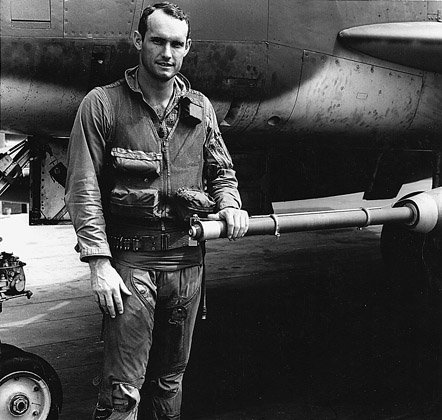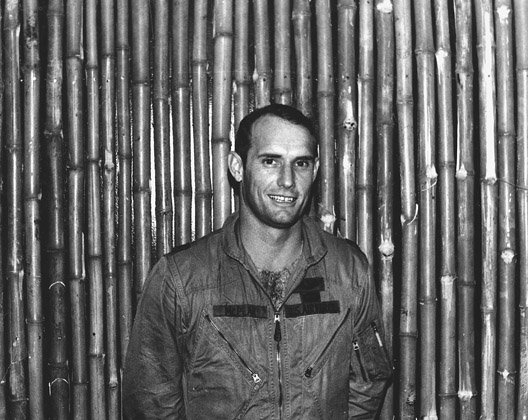Student pilot, Hondo Air Base, 1958, in the earmuff headset worn before the era of jet helmets.
Starfighter pilot, George AFB, January 1960. I found some excuse to wear my spurs whenever possible.
Scramble from the Moron alert pad, fall 1960. If you kept your g-suit and spurs on, you could just about get airborne in five minutes.
79th Fighter Squadron, RAF Woodbridge, 1962. Two future Air Force chiefs of staff: front row left, Tony McPeak; front row right, Mike Dugan. Front row without hat, Lt. Col. Bill Georgi, an outstanding squadron commander.
New Thunderbird solo pilot, Nellis AFB, January 1967.
Solo formation takeoff, Nellis, January 1967. Wheels already up and locked, landing gear doors closing. Make a note: When Beckel says he’ll get the wheels up quickly, he means quickly. And after we get the gear doors closed, he’s going to lower the nose.
With Bobby in Calypso, Palmdale, California, 1967.
Bouncing smoke off the ground at the entry of the Opposing Slow Roll. If I get it right, I’ll miss, but feel him go by.
Bobby and I start up into an Opposing Loop.
After the Diamond separates for the Bomb Burst, the solo pilot pulls up through the smoke to do vertical rolls, the “pigtails.” This is what the early part of the maneuver should look like. At Del Rio, Texas, 21 October 1967, I didn’t get very far into the pull.
The wings are gone and what’s left of Number Six is on fire, with one of the Diamond aircraft above. Photo taken from video made by a spectator.
Me hanging in the parachute, with my survival kit and life raft dangling below.
My canopy.
When the engine exploded it blew off the first six feet of the intake.
The wreckage of Number Six.
Mike and I in Calypso, 1968.
Mike and I pass each other on top an Opposing Loop. Tops were hard. Getting them right made up for a lot of other mistakes.
Haney and Miller join the Wedge to form the Outhouse formation.
Landing gear and flaps down for the Wing Rock and Roll, Nellis AFB, 1968.
Southeast Asia, 1968–69
Getting ready to launch with “slick” bombs and fuse extenders (daisy cutters), Phu Cat, January 1969. We sometimes used daisy cutters so the bomb would go off a little before ground impact, producing better blast effects.
The Misty squadron logs 10,000 flying hours on the Ho Chi Minh Trail. Standing, second and third from left, Tony McPeak and Ron Fogleman, two future Air Force chiefs. Next to Fogleman, Dick Hepworth, eighth commander of Misty. Standing, far left, Bill Creech, later the enormously influential commander of Tactical Air Command. Standing far right, Leroy Manor, commander of the 37th Fighter Wing.
Three trucks destroyed, with sacks of supplies, March 1969. These were Russian-built ZIL 157s, good trucks, but pounded hard by us and the trail.
Seven destroyed or damaged trucks, May 1969. Those tough-guy truck drivers continued to put through the equipment and supplies that would, in the end, surround and capture the Saigon of memory.
The river fords at Ban Laboy, north of Tchepone, February 1969, showing (dashed line) the Ho Chi Minh Trail and its bypasses. We reduced much of Laos to bony, lunar dust.
In April 1969, I became the ninth commander of the Misty squadron.


























